Terracotta Temples of Bengal
The construction of terracotta temples in Bengal flourished during the medieval period, particularly after the decline of the Bengal Sultanate. With the rise of powerful Hindu rulers, such as the kings of Bishnupur and the Nawabs of Murshidabad, Bengal experienced a cultural renaissance that enhanced artistic expression. Bishnupur, known for its exquisite terracotta temples, became the center of this artistic movement. The Malla dynasty ruler, Krishna Singha, built numerous temples entirely out of terracotta. This architectural style spread across various villages and cities, supported by local rulers. Constructed during the Bhakti movement, these temples predominantly depict themes of devotion to the Vaishnava cult, with intricate terracotta panels illustrating mythological stories, religious scenes, floral motifs, geometric patterns, and daily life. Architecture of the temple developed in a distinctive style, diverging from the Nagara and Dravidian styles, and is notable for its detailed ornamental elements and storytelling panels from the Ramayana and Mahabharata. Influences from Islamic architecture are also evident, particularly in the use of arabesque floral designs.
Bishnupur Village
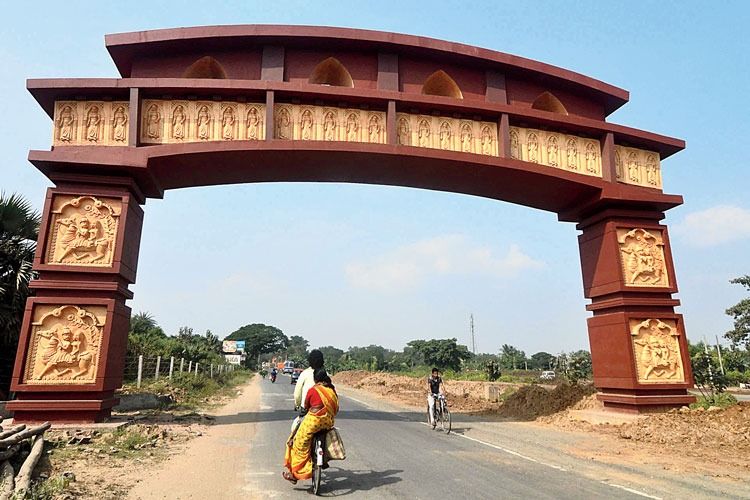
Bishnupur village entry gate (image source: Anandabazar)
Located 129 kilometers from Kolkata, the capital of West Bengal. This historic site was built by the Malla kings, who ruled a region of West Bengal between Burdwan and Purulia. These rulers, being devout Vaishnavites, constructed stunning terracotta temples during the 17th and 18th centuries. The temples are dedicated to Lord Vishnu and Radha, which is why the town is named ‘Bishnupur.’ These temples were built over 700 years, spanning from the 10th to the 17th century, and consist of 20 temples in total. Bishnupur's temples are currently on UNESCO's tentative list of World Heritage Sites.
Jor Bangla Temple
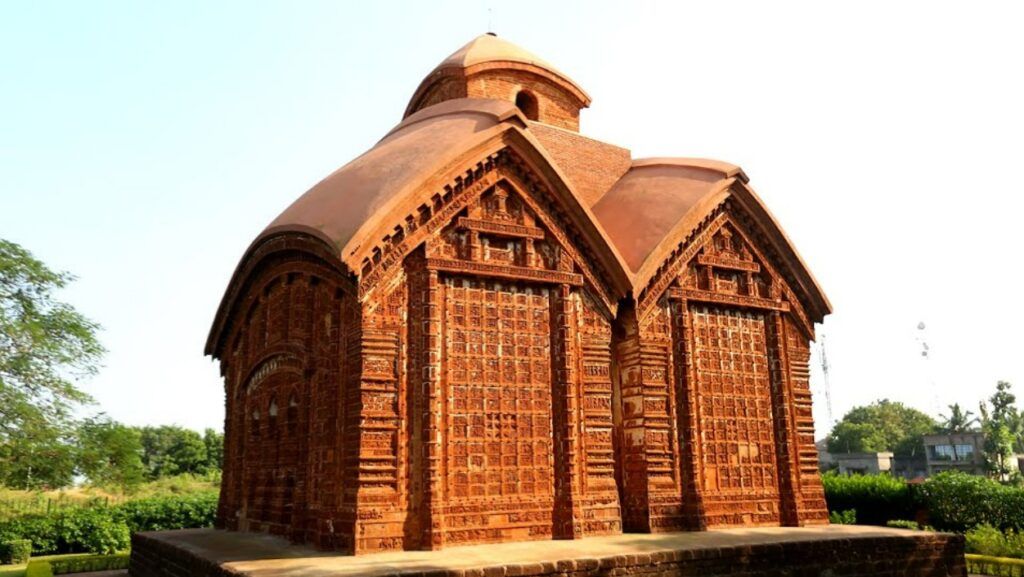
Jor Bangla Temple (image source: Google Arts and Culture)
Also called Keshta Rai Temple, it was built in 1655 AD by Malla King Raghunath Singh Dev II. It features terracotta carvings and reflects the 'chala' form of Bengal architecture. The temple structure consists of two 'do chala' village huts placed side by side, which is how it earned the name Jor Bangla. One hut serves as a porch, and the other, located behind, is a shrine. The curved roof of these huts is topped with a 'char chala shikhara'. The temple’s base is a square measuring 11.8 square meters, with a height of 10.7 meters above the platform. Its walls depict scenes from the Mahabharata and Ramayana, with detailed terracotta carvings telling stories such as Krishna's childhood, Bhishma on the bed of arrows, Ram and Sita's marriage, Maa Parvati with her sons, and the tale of Lakshman and Surpanakha. The richness of these carvings allows the stories to be visually narrated in remarkable detail.
Pancha Ratna Temple
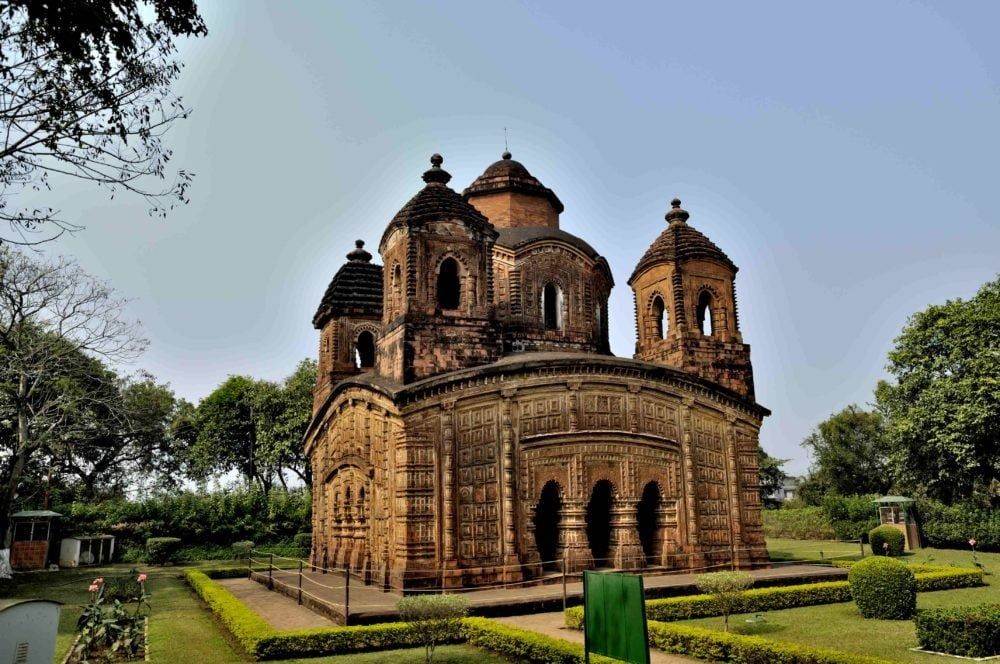
Pancha Ratna Temple (image source: Whizzed Net)
Built by King Raghunath Singh in 1643 popularly known as Shyam Rai Temple. Because it has five pinnacles, it earns the name 'Panchura'. The temple stands on a low square base with a path leading to a porch featuring three arches on each of its four sides. The central shikhara is round, while the other four are square, resting on a sloping roof in the 'Pida' order. Both the interior and exterior panels display intricate terracotta art, depicting scenes from Krishna Leela, episodes of the Ramayana and Mahabharata, as well as the socio-economic and political life of the period. Dedicated to Vishnu in his Krishna avatar, it is one of the oldest surviving temples of its kind in West Bengal. In Bengali, 'Pancha Ratna' means 'five gems', symbolised by the temple's five towers. Each side of the temple has triple multi-cusped arched gateways, surrounding a well-paved path.
Rasmancha Temple
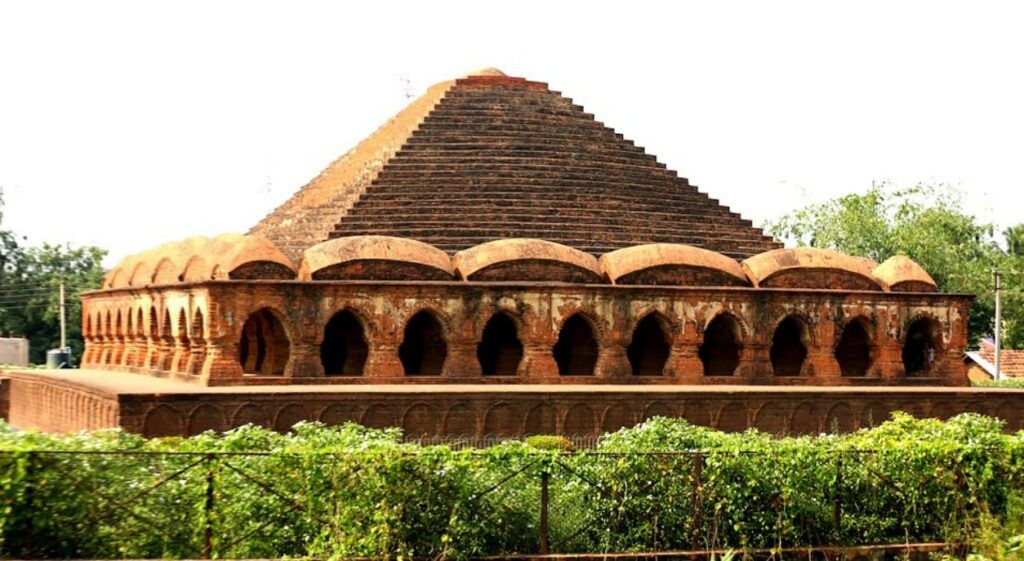
Ramsancha temple (image source: Google Arts and Culture)
Built in 1600 AD by King Hambir Malla Dev, this oldest brick temple is renowned for its unique architectural style. It features an elongated pyramidal tower, surrounded by hut-shaped turrets known as 'Chala.' It stands on a square platform measuring 24.5m x 24.5m, made from Laterite blocks, with a 1.5m high foundation. The temple itself reaches a height of 12.5m and includes three circumambulatory galleries, tranquil pillars, and arches adorned with terracotta lotus motifs. A passageway surrounds the structure, adding to its grandeur. The ceiling is supported by 40 pillars and arches, which are intricately decorated with artwork of flowers and human figures, enhancing the overall aesthetic.
Char Bangla Temple
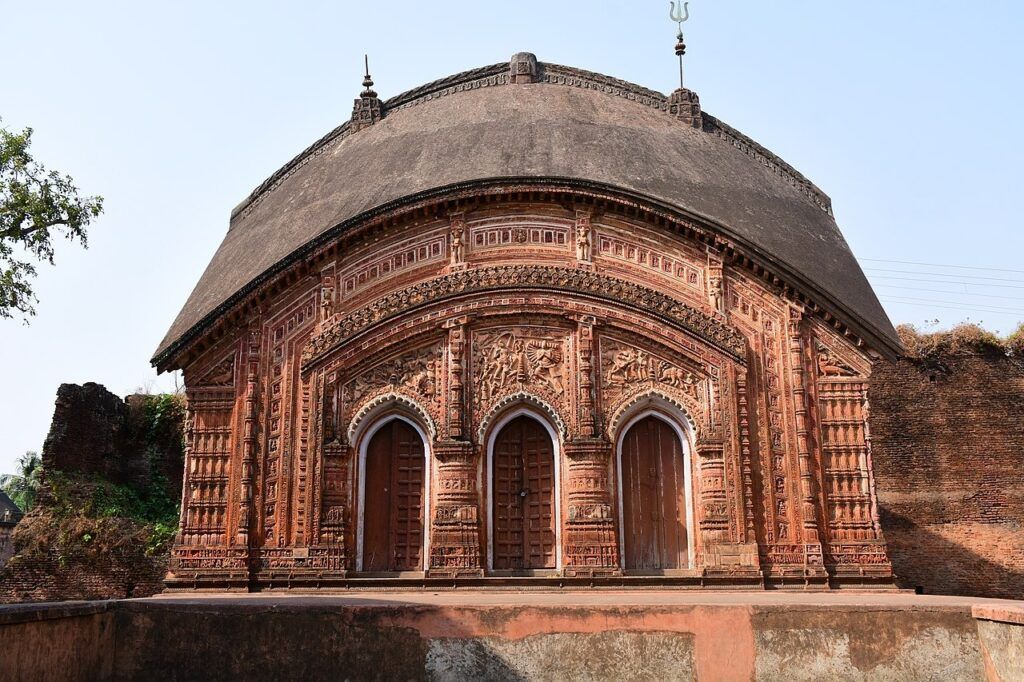
Char Bangla Temple (image source: Wikipedia)
In Murshidabad, the well-known Char Bangla temples, built in 1755 by Rani Bhabani, are a renowned example of terracotta architecture. She aimed to transform Barangar, where the temples stand, into a second Varanasi. This temple complex consists of four Shiva temples, built in the 'do chala' or 'ek bangla' style. The name Char Bangla comes from the cluster of four temples, each positioned on a 1.5-foot platform in the four cardinal directions. Three of the temples feature intricate terracotta ornamentation, while the fourth is adorned with elaborate stucco work. Each temple has three doors and houses a Shiva Linga. Exquisite sculptures of Durga, Kali, and Shiva, along with his attendants Nandi and Bhringi, decorate the walls. Scenes from the Ramayana and Mahabharata, as well as depictions of daily life, soldiers, animals, and floral motifs, further enhance the beauty of this sacred site.
Radheshyam Temple
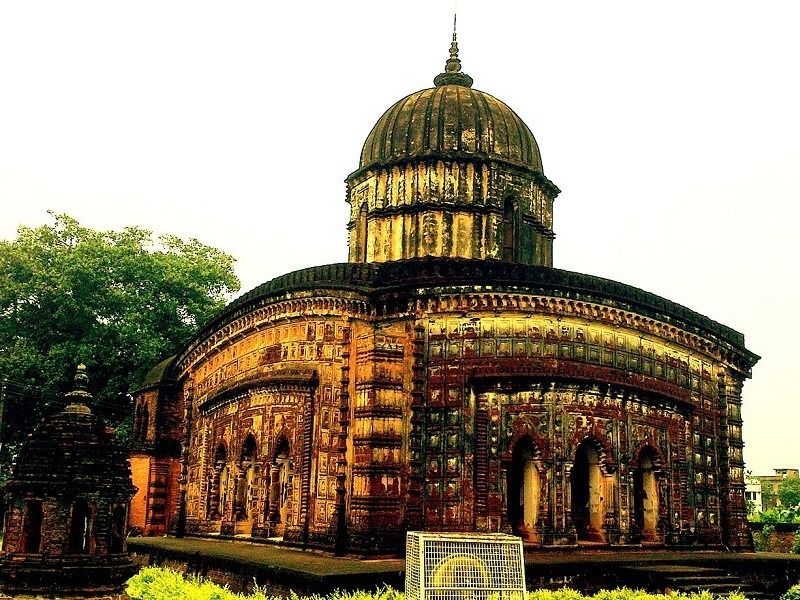
Radheshyam Temple (image source: trawell)
Constructed in 1759 AD by Malla King Chaitanya Singha, this temple is a remarkable example of the 'Ek Ratna' architectural style. With a square base measuring 11.1 metres and rising to a height of 10.7 metres, the structure boasts a cylindrical spire topped with a hemispherical dome. The temple is made from laterite stone and decorated with terracotta reliefs depicting stories from the Ramayana and the Dashavatara of Vishnu. One of the most captivating details is the relief of Vishnu resting on Ananta, seen both inside and outside the temple. Although weathered, the entrance arches still display intricate scenes from Krishna Leela and Vaishnavite iconography, offering a glimpse into the devotional artistry of the Malla kingdom.
In conclusion,
The terracotta temples of medieval Bengal mark an important milestone in India’s history, combining architectural ingenuity with rich cultural narratives. These temples stand as unique examples of artistic craftsmanship deeply intertwined with regional traditions. As historical monuments, they offer valuable insights into the religious, social, political, and artistic life of Bengal during this time. Today, these temples stand as enduring symbols of Bengal’s artistic heritage and cultural diversity, representing a unique blend of indigenous traditions that continue to inspire admiration.
To learn more about Indian art and artists, download the Rooftop app from the App Store or Google Play to stay updated on our upcoming art events and workshops. Stay tuned to rooftop blogs and follow us on @rooftop_app.
By Shrushti Patel